What Is Different About Painting With God?
So What’s the Difference?
As you would expect, painting with God differs from painting for a secular audience in several major ways. Obviously, there are differences between what the artist who is seeking to glorify God and a secular artist create. The following is an outline of some of those differences and there are huge areas of overlap. It uses the term prophetic, but that could also be interpreted as the art created by Christians.
I believe that God wants to raise a huge number of extraordinary artists who create amazing works that can compete in any secular field for standard and excellence. He wants His children to create works which make people stop in their tracks and gasp with wonder.
I really believe that God wants to bring back beauty into art. The kind of beauty that does make people stop and gasp in awe. The kind of beauty that reflects the glory of His world and His creation. The kind that points people back to an awareness of the overwhelming complexity of the creation that surrounds us, but that so many people take for granted.
In order to do this, some concepts need to be aligned with His Kingdom principles.
Purpose
The basic purpose of prophetic art is different from secular art in that worship and prophetic art reveals the Father’s meanings, not the artist’s. It seeks to reveal messages from God in a visual form rather than to portray the artist’s own subject matter. It may comment on environmental, political or any other issues – if that’s what God has purposed. For instance, it may be that God brings about a passion for an environmental issue that compels the artist to create works that highlight and elucidate the problem. It’s certainly not assuming that prophetic art wouldn’t be used to comment on such issues, but the primary purpose is God’s intention, not man’s. As mentioned previously, a Christian artist’s purpose is to glorify the Creator.
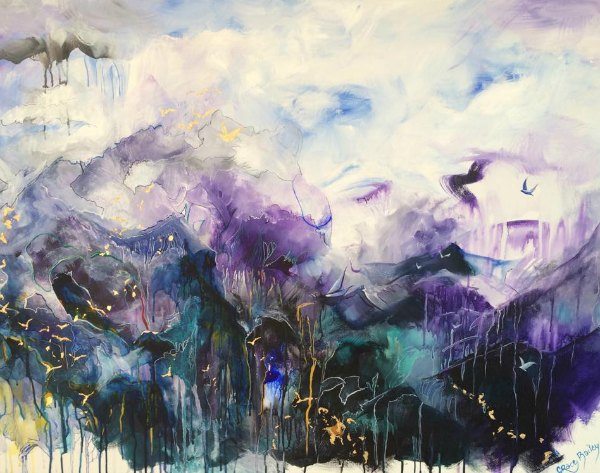
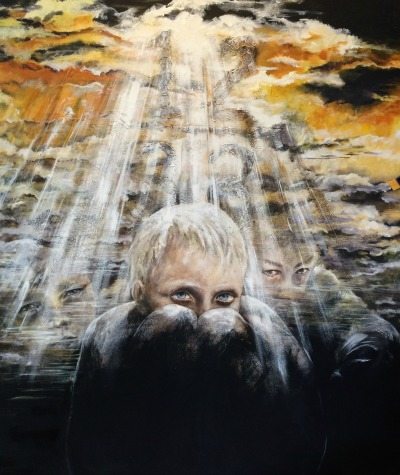
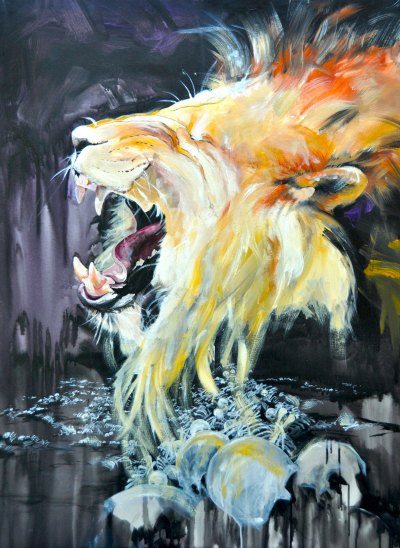
Positive Subject Matter
Another area of difference is that the subject matter is always positive in intent. The essence of prophecy as mentioned before is to encourage, exhort or comfort. That is not to say that it couldn’t deal with darker issues like death or pain or other popular secular topics. The work I created titled ‘Valley of Dry Bones? Ha! Piece of Cake!’ is full of skeletons, but the heart behind the work is not a focus on death, but on hope renewed. The work and its meaning are explained more fully in my instant download book, Painting With God, available here
The painting that I did on sexual abuse by priests perpetrated on young boys discussed in Chapter 1 of Painting With God, prompted a viewer at the exhibition to loudly declare that it was ‘horrendous’ to those around him. On the surface, the focus was horrific, the suicide of 12 boys from a class of 33, but the underlying purpose was hope in the face of terrible circumstances. The school bought the work to hang in a special place. This painting and its meaning are explained in detail in the online course, Understanding Prophetic Art. The meanings are layered and although it deals with a very difficult topic, the intent is a positive one.
Another story involves an artist who knew a girl with life-threatening anorexia. God prompted the artist to paint a work that depicted demons that she hung on her wall and which prompted her to pray for the girl repeatedly. So even though on the surface this work didn’t have a positive subject matter, it actually represented a breakthrough for the young girl and was an instrument in bringing about major healing. It all comes back to the underlying intent of the work.
Artist as Instrument
Within the art world, there’s a tacit maxim that an artist’s works are an expression of their inner selves and therefore everything is acceptable. Prophetic art, however, is an expression of God’s voice in collaboration with the artist. The artist is the instrument of execution, not the primary source. This is one of the major differences from secular art. The artist needs to lay down their own agenda in order to convey what God is saying.
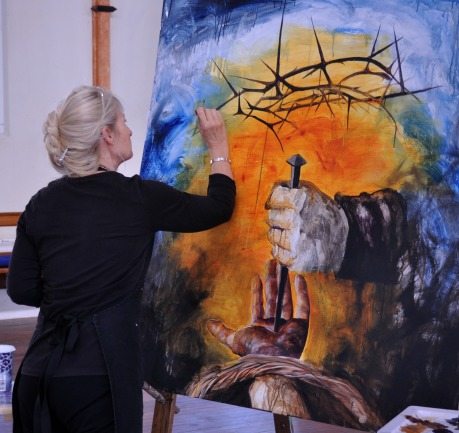

Redemption of Art
Another difference is about the redemption of art from the dark and the morbid, to light and life and hope. That’s a pretty big call and an awesome role. It requires dedication, skill-building and commitment. It also requires collaboration with Holy Spirit. An artist who is a Christian may not specifically seek to create images that are messages from God, but there’s a paradigm shift in thinking when an artist embraces the concept that everything that they create is meant to glorify God. When they realize the awesome privilege and responsibility of painting with God-inspired methods and imagery, the purpose changes to somehow reflect the glory of God.
The subject matter and perhaps the unseen attention to the quality of materials and integrity is influenced. Where it’s easy to see art as less important than most other income-producing activities, it then takes on the importance that it was meant to have.
God has called the artists to reflect His creation and His glory. God is the first artist. His creation is absolutely gobsmacking. His art is so out-there. Just look at the complexity in a bottlebrush or in different types of tears (water-drops) or the amazing array of South American birds. There’s a Facebook page called Biblical Creation that has lots of examples of extraordinary birds and animals, which we’d call amazing artworks if they were done on canvas rather than in real life.
In academia and arts writing, there is so much obfuscation of meaning, intent, and quality. Reviews are written in language that seems to be more about the ego of the writer in displaying their use of unintelligible multi-syllabic words than in communicating. How good an artist is has been determined by the opinions and critiques of a few because the masses didn’t understand and perhaps there was a culture of deliberately keeping it that way, to the point that if an artist or artwork was popular with the masses, it was dismissed as populist and therefore confined to oblivion by critics. I've written quite a lot about this topic in my book, Painting With God. Did you realise for instance, that Thomas Kinkade, a famous painter of popular scenes was completely lampooned by art critics even though he sold more work (meaning that more people liked his work) than any other living artist at that time?
Art has almost been kept in a rarified atmosphere to infer a mystery and substance when God intended it to actually have real substance and worth, to reflect His glory. It’s brought about such a dearth in the quality of art that many people don’t want to look at it with the result that so many artists can’t make a living, which leads to the resultant frustration, disappointment and sometimes despair that comes with not pursuing the calling you were designed for.
Start Your Own Prophetic Art Adventure With The 'Painting With God" book.
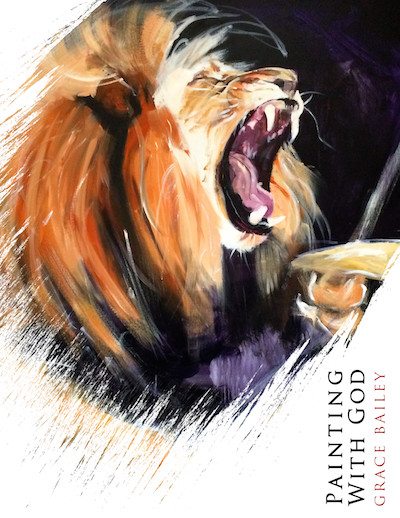
You'll be guided by experienced artist, Grace Bailey, through ten colorful chapters on how to get started, face your fears and create images that tell God-stories.

Reveals the Unseen
Sometimes, prophetic art reveals a glimpse of the spiritual world around us. The example in Chapter 3 of the lion supernaturally revealed behind the eagle, ‘The Apostle and the Prophet’ translated the unseen into the seen. Similarly, ‘We Are Not Alone’, also described in Chapter 3, revealed aspects of the supernatural entities that surround us without me being aware that that was what I was painting.
There are a number of examples of artists painting scenes that they have seen in heaven. Tony Mason is an Australian artist who regularly paints the spiritual world around us. This is what he says about painting the unseen: “Heaven is an amazing place, filled with endless adventure and creativity. The colors, sound, dance, food and fashion that encompasses all generations, tribes and nations is enough to tell you that it’s pure freedom and perfectly designed. When I see heaven I know it’s right and I know it’s His will for it to be manifested on the earth in all aspects of creation: in song, in picture, in words, in dreams, in our lifestyles merged within reverence, adoration, honor and love for all he has done.
“However, in all that you can do there seems to be one thing that remains. It’s as though heaven has a way of leading you right back to what matters most. Your Father and His love. Having an eternal ability to talk to him as he fills the body of a man Jesus, to speak to you in your language, on your level of understanding, seems to pull all things into perspective. His love remains for all eternity, and this love forms the worship that lifts the King higher, and then in turn inhabits every fiber of your being. It’s my passion to see the saints rise and do what they will do for all eternity, now.”

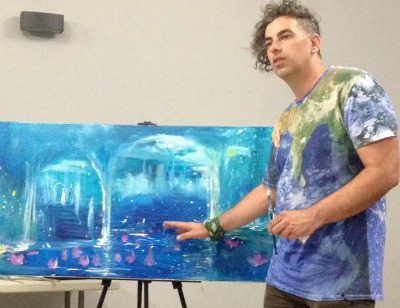
Often Beautiful
Prophetic art usually seeks to create images that are unashamedly beautiful. Dealing with images of hope such as brides, lambs and paradise can often create images that are beautiful to look at but that would be deemed passé or trite in many secular circles. The Bible was written in an agricultural society and uses metaphor and analogy throughout. Paintings of that sort of subject matter are often seen as facile by secularists but deeply moving if received with biblical understanding. The primary element running through the whole of Christendom is love.
Abstract art created as prophetic art similarly tends towards beauty rather than shock or morbidity. Possibly the foremost example of that kind of art is that produced by Makoto Fujimura. (24). In fact, it was through his video about beauty in art, discussed in Chapter 2, that I first began the journey back to believing that art can and should be beautiful. If something or someone is beautiful, we naturally want to look at it. It’s a subconscious reaction to beauty. If art is beautiful, more people are going to want to look at it. Of course, different people appreciate different aspects of beauty, but the principle remains that we are drawn to beauty, so it makes sense to create works of beauty.
It’s Not About Ego.
Many secular Australian artists would measure success as winning major prizes, being hung in prestigious galleries or favorably reviewed by distinguished critics. Success as a prophetic artist however is more attuned to the effect a work can have on an individual or the lives that are affected by the work. In other words, it’s not about the ego of the artist, but the glory of the Father. That doesn’t mean that prophetic artists shouldn’t go after those things but that recognition is not the primary underlying motivator. The motivating force is more about the purposes of God than prestige or critical acclaim.
Touched by God
I wish I could say that all the paintings produced during my worship were touched by God and therefore extraordinary for healing or edification or comfort. I believe however, that just as the early Christians saw Peter’s hankies touched by God, we’ll begin to see more and more of the supernatural displayed through worship and prophetic art. As I’ve said before; bring it!!
The Less Positive Side
The one glaring difference between prophetic or Christian art and secular art is that the overall standard is so much worse. Matt Tommey writes in his book Unlocking the Heart of the Artist, (25) that the first question asked of him on Moody radio, a large Christian radio station in the States, was “Why is Christian art so bad?” This evidences a pervasive attitude. Very poor work is accepted and indeed lauded if the ‘God factor’ shines. While I recognize that such work can be created by earnest individuals who have a real heart for the Lord and who may demonstrate extraordinary prophetic ability, such work shouldn’t be widely published. It’s not enough to be well-meaning, unless the audience is very small. I realize that often prophetic pieces are given to individuals and can bring about remarkable God moments, but those pieces should be kept for private.
To use the music analogy again, if someone loved to sing but couldn’t hold a tune, they wouldn’t (or shouldn’t!) expect to sing with a microphone on stage, but we have artists of a similar standard painting on stages when their skill level should relegate them to private painting or at least less public display.
I realize that churches have to work with the personnel they have available for their music teams and sometimes it’s a real challenge to find committed, competent musicians who are prepared to give copious volunteer hours to facilitate other people’s worship and of course, the same goes for worship artists. I also realize that there are lots of issues surrounding standards with both music and painting, but somewhere we need to recognize that not all painting is equal and that just because the artists are earnest and committed it doesn’t mean that they should then have the opportunity to create live worship art for a public audience. Perhaps the answer in that case is that an area at the back of the auditorium be made available for aspiring worship artists. That way, the artists still get to express their corporate worship and perhaps release the Spirit, but it is more private.
For all those who are now bristling with indignation, the reason I advocate this is because the perception of the standard of most worship art is rightfully very low. It is not the kind of art that most people will be stopped in their tracks by and will need a second look at, let alone the kind of ‘great’ art that causes an emotional reaction in the viewer. If a Christian broadcaster can ask the question referred to above about why Christian art is so bad, in front of millions of people, clearly there is an issue. It’s a discussion that the church needs to enter into.
As well, if God is raising an army of artists and creating a Renaissance of the arts in Christendom, the standard of Christian art must improve. It must begin to move towards a place that can compete in terms of standards with the best of secular art. It is no longer acceptable to excuse the obvious lack of skills because it was created with good intentions for heartfelt reasons.
We are called to be the head and not the tail and that extends to art, but most of what is purported to be Christian art does not begin to compete in terms of standards. Much of it does not cause you to stop and look twice, and very little of it causes you to gasp in wonder. Certainly God uses works to speak to people and create emotional connection, but if the standard was high enough to be hung in public galleries and to be seen in large corporate institutions, the reach and purpose of that art would be far greater.
I’m very excited that worship art is gaining acceptance in more and more churches and I’m pleased that it performs the purposes outlined in Chapter 2. But we, the church, should pursue excellence in particularly public worship and recognize that some ‘art’ is a private expression better suited to the prayer closet.
Start Your Own Prophetic Art Adventure With The 'Painting With God" book.

You'll be guided by experienced artist, Grace Bailey, through ten colorful chapters on how to get started, face your fears and create images that tell God-stories.
